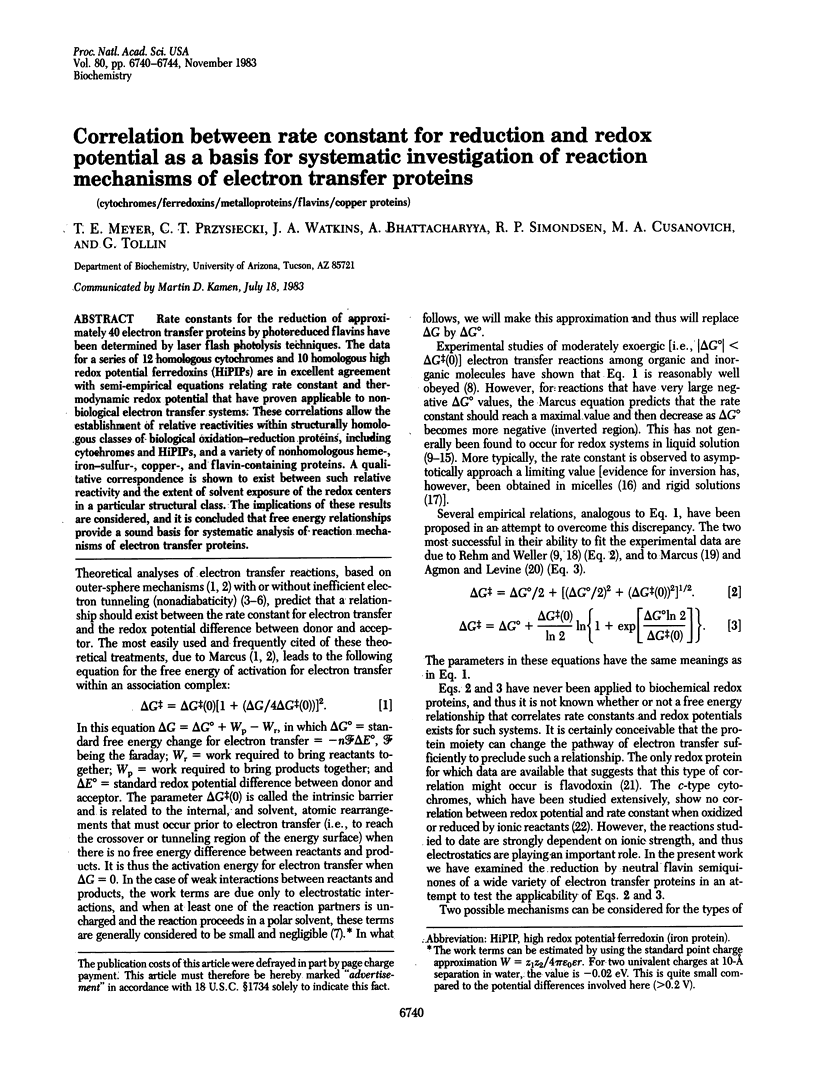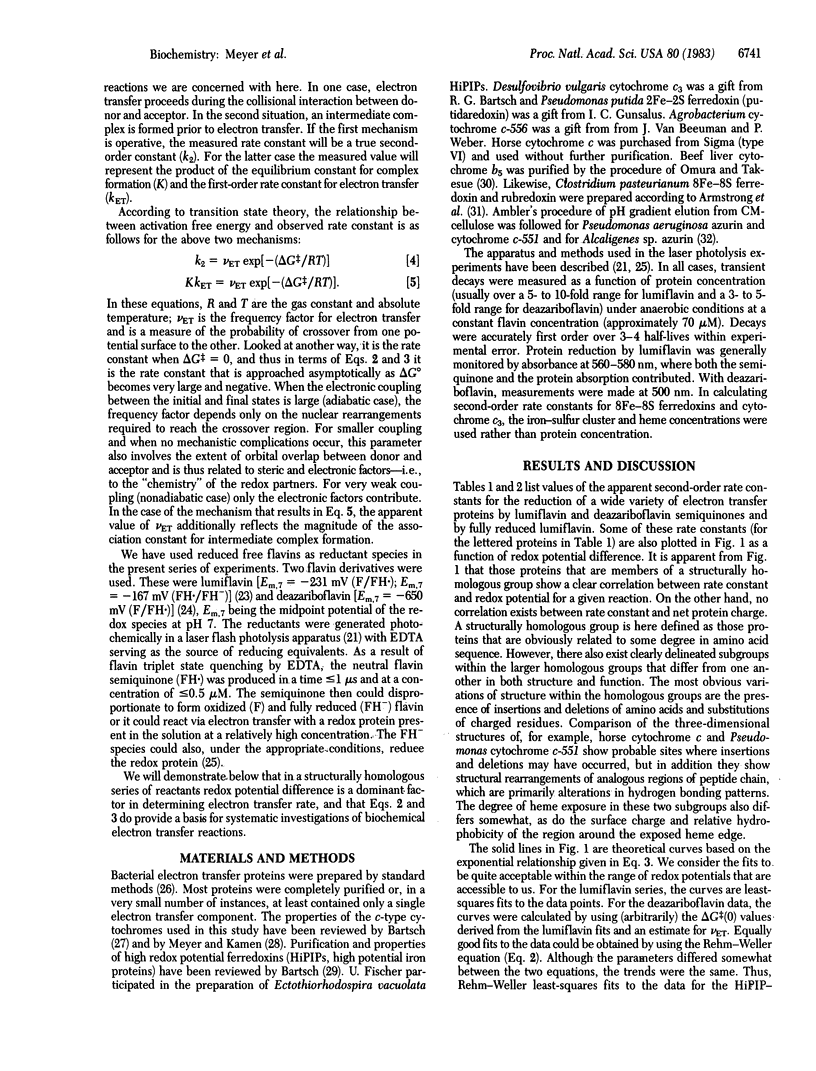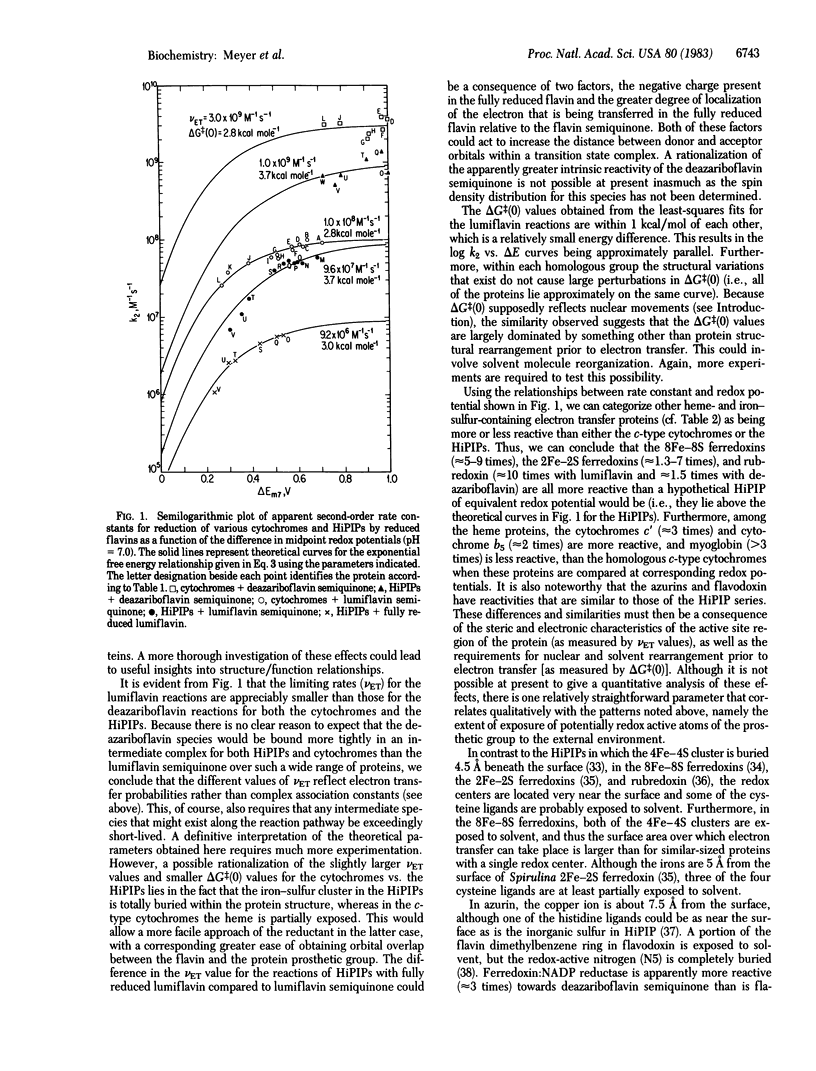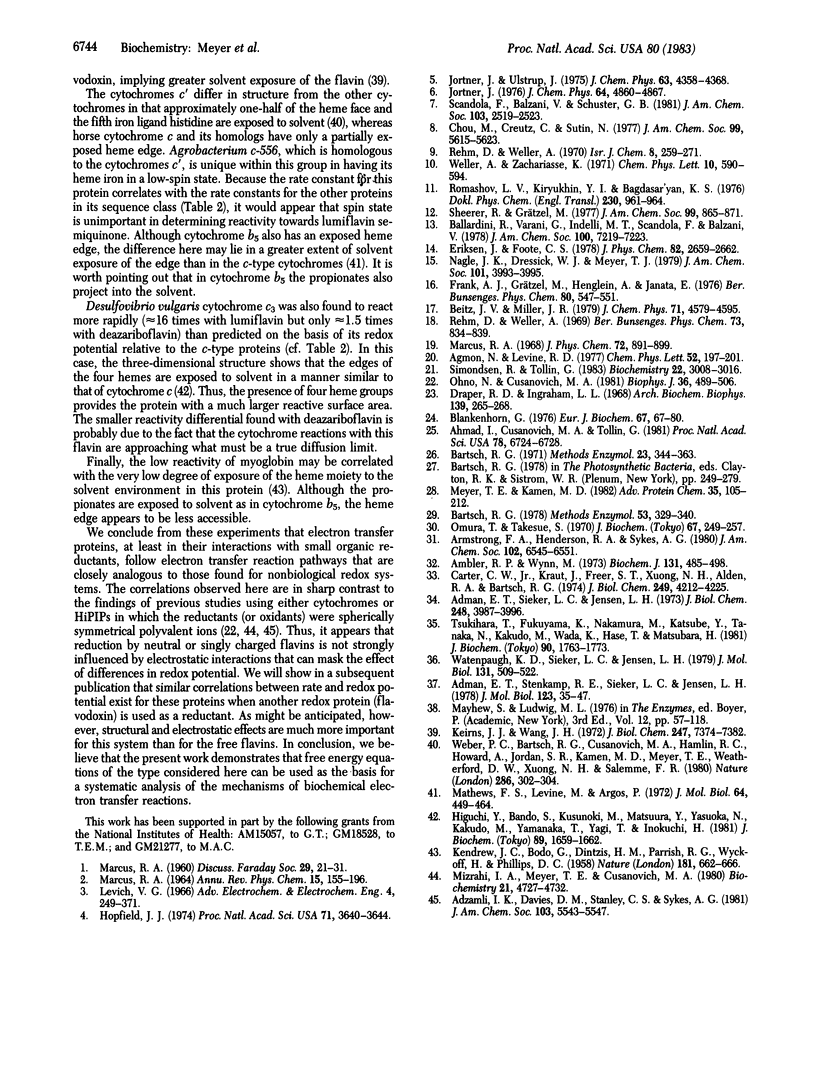Abstract
Rate constants for the reduction of approximately 40 electron transfer proteins by photoreduced flavins have been determined by laser flash photolysis techniques. The data for a series of 12 homologous cytochromes and 10 homologous high redox potential ferredoxins (HiPIPs) are in excellent agreement with semi-empirical equations relating rate constant and thermodynamic redox potential that have proven applicable to nonbiological electron transfer systems. These correlations allow the establishment of relative reactivities within structurally homologous classes of biological oxidation-reduction proteins, including cytochromes and HiPIPs, and a variety of nonhomologous heme-, iron-sulfur-, copper-, and flavin-containing proteins. A qualitative correspondence is shown to exist between such relative reactivity and the extent of solvent exposure of the redox centers in a particular structural class. The implications of these results are considered, and it is concluded that free energy relationships provide a sound basis for systematic analysis of reaction mechanisms of electron transfer proteins.
Full text
PDF




Selected References
These references are in PubMed. This may not be the complete list of references from this article.
- Adman E. T., Sieker L. C., Jensen L. H. Structure of a bacterial ferredoxin. J Biol Chem. 1973 Jun 10;248(11):3987–3996. [PubMed] [Google Scholar]
- Adman E. T., Stenkamp R. E., Sieker L. C., Jensen L. H. A crystallographic model for azurin a 3 A resolution. J Mol Biol. 1978 Jul 25;123(1):35–47. doi: 10.1016/0022-2836(78)90375-3. [DOI] [PubMed] [Google Scholar]
- Ahmad I., Cusanovich M. A., Tollin G. Laser flash photolysis studies of electron transfer between semiquinone and fully reduced free flavins and horse heart cytochrome c. Proc Natl Acad Sci U S A. 1981 Nov;78(11):6724–6728. doi: 10.1073/pnas.78.11.6724. [DOI] [PMC free article] [PubMed] [Google Scholar]
- Ambler R. P., Wynn M. The amino acid sequences of cytochromes c-551 from three species of Pseudomonas. Biochem J. 1973 Mar;131(3):485–498. doi: 10.1042/bj1310485. [DOI] [PMC free article] [PubMed] [Google Scholar]
- Bartsch R. G. Purification of (4Fe-4S)1--2--ferredoxins (high-potential iron--sulfur proteins) from bacteria. Methods Enzymol. 1978;53:329–340. doi: 10.1016/s0076-6879(78)53038-3. [DOI] [PubMed] [Google Scholar]
- Blankenhorn G. Nicotinamide-dependent one-electron and two-electron (flavin) oxidoreduction: thermodynamics, kinetics, and mechanism. Eur J Biochem. 1976 Aug 1;67(1):67–80. doi: 10.1111/j.1432-1033.1976.tb10634.x. [DOI] [PubMed] [Google Scholar]
- Carter C. W., Jr, Kraut J., Freer S. T., Nguyen-Huu-Xuong, Alden R. A., Bartsch R. G. Two-Angstrom crystal structure of oxidized Chromatium high potential iron protein. J Biol Chem. 1974 Jul 10;249(13):4212–4225. [PubMed] [Google Scholar]
- Draper R. D., Ingraham L. L. The affinity of flavin semiquinones for certain aromatic compounds and disulfides. Arch Biochem Biophys. 1970 Aug;139(2):265–268. doi: 10.1016/0003-9861(70)90477-7. [DOI] [PubMed] [Google Scholar]
- Higuchi Y., Bando S., Kusunoki M., Matsuura Y., Yasuoka N., Kakudo M., Yamanaka T., Yagi T., Inokuchi H. The structure of cytochrome c3 from Desulfovibrio vulgaris Miyazaki at 2.5 A resolution. J Biochem. 1981 May;89(5):1659–1662. doi: 10.1093/oxfordjournals.jbchem.a133364. [DOI] [PubMed] [Google Scholar]
- Hopfield J. J. Electron transfer between biological molecules by thermally activated tunneling. Proc Natl Acad Sci U S A. 1974 Sep;71(9):3640–3644. doi: 10.1073/pnas.71.9.3640. [DOI] [PMC free article] [PubMed] [Google Scholar]
- KENDREW J. C., BODO G., DINTZIS H. M., PARRISH R. G., WYCKOFF H., PHILLIPS D. C. A three-dimensional model of the myoglobin molecule obtained by x-ray analysis. Nature. 1958 Mar 8;181(4610):662–666. doi: 10.1038/181662a0. [DOI] [PubMed] [Google Scholar]
- Keirns J. J., Wang J. H. Studies on nicotinamide adenine dinucleotide phosphate reductase of spinach chloroplasts. J Biol Chem. 1972 Nov 25;247(22):7374–7382. [PubMed] [Google Scholar]
- Mathews F. S., Levine M., Argos P. Three-dimensional Fourier synthesis of calf liver cytochrome b 5 at 2-8 A resolution. J Mol Biol. 1972 Mar 14;64(2):449–464. doi: 10.1016/0022-2836(72)90510-4. [DOI] [PubMed] [Google Scholar]
- Meyer T. E., Kamen M. D. New perspectives on c-type cytochromes. Adv Protein Chem. 1982;35:105–212. doi: 10.1016/s0065-3233(08)60469-6. [DOI] [PubMed] [Google Scholar]
- Mizrahi I. A., Meyer T. E., Cusanovich M. A. Kinetics of oxidation and reduction of high-potential iron-sulfur proteins with nonphysiological reactants. Biochemistry. 1980 Oct 14;19(21):4727–4733. doi: 10.1021/bi00562a001. [DOI] [PubMed] [Google Scholar]
- Omura T., Takesue S. A new method for simultaneous purification of cytochrome b5 and NADPH-cytochrome c reductase from rat liver microsomes. J Biochem. 1970 Feb;67(2):249–257. doi: 10.1093/oxfordjournals.jbchem.a129248. [DOI] [PubMed] [Google Scholar]
- Simondsen R. P., Tollin G. Transient kinetics of redox reactions of flavodoxin: effects of chemical modification of the flavin mononucleotide prosthetic group on the dynamics of intermediate complex formation and electron transfer. Biochemistry. 1983 Jun 7;22(12):3008–3016. doi: 10.1021/bi00281a034. [DOI] [PubMed] [Google Scholar]
- Tsukihira T., Fukuyama K., Nakamura M., Katsube Y., Tanaka N., Kakudo M., Wada K., Hase T., Matsubara H. X-ray analysis of a [2Fe-2S] ferrodoxin from Spirulina platensis. Main chain fold and location of side chains at 2.5 A resolution. J Biochem. 1981 Dec;90(6):1763–1773. doi: 10.1093/oxfordjournals.jbchem.a133654. [DOI] [PubMed] [Google Scholar]
- Watenpaugh K. D., Sieker L. C., Jensen L. H. The structure of rubredoxin at 1.2 A resolution. J Mol Biol. 1979 Jul 5;131(3):509–522. doi: 10.1016/0022-2836(79)90005-6. [DOI] [PubMed] [Google Scholar]
- Weber P. C., Bartsch R. G., Cusanovich M. A., Hamlin R. C., Howard A., Jordan S. R., Kamen M. D., Meyer T. E., Weatherford D. W., Nguyen huu Xuong Structure of cytochrome c': a dimeric, high-spin haem protein. Nature. 1980 Jul 17;286(5770):302–304. doi: 10.1038/286302a0. [DOI] [PubMed] [Google Scholar]


